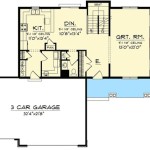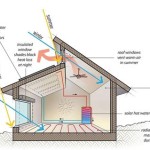Building plans are detailed technical drawings that outline the design, structure, and systems of a house. They serve as a comprehensive guide for contractors and builders during the construction process.
Obtaining building plans for your house is a crucial step in the homebuilding process. It allows you to visualize your dream home, estimate construction costs, comply with building codes, and ensure a smooth and efficient building process. Before embarking on this undertaking, it’s essential to understand the different methods available for acquiring building plans.
In this article, we will explore the various options for obtaining building plans for your house, including working with an architect, purchasing stock plans, and exploring free or low-cost resources. We will also discuss the factors to consider when choosing the right plan for your needs, and provide guidance on interpreting and understanding building plans.
Obtaining building plans for your house involves several key steps.
- Hire an architect
- Purchase stock plans
- Use free or low-cost resources
- Consider your needs and budget
- Interpret and understand plans
- Make necessary modifications
- Obtain building permits
- Start construction
By following these steps and carefully considering the factors involved, you can ensure that you have the right building plans for your house and that your construction project is a success.
Hire an architect
Hiring an architect is the most comprehensive and personalized approach to obtaining building plans for your house. Architects are licensed professionals with the education, training, and experience to design and produce custom building plans that meet your specific needs and preferences.
When you hire an architect, you will work closely with them to develop a design that reflects your vision and lifestyle. The architect will consider factors such as the size and layout of your house, the materials you want to use, the energy efficiency of the design, and the overall aesthetic appeal.
The architect will also be responsible for producing detailed construction drawings that will be used by contractors to build your house. These drawings will include floor plans, elevations, sections, and details, as well as specifications for materials and finishes.
Hiring an architect is a more expensive option than purchasing stock plans or using free resources, but it offers the greatest degree of customization and control over the design of your house.
Here are some of the benefits of hiring an architect to create building plans for your house:
- Custom design tailored to your specific needs and preferences
- Detailed construction drawings that ensure a smooth and efficient building process
- Expertise in building codes and regulations
- Peace of mind knowing that your house is being designed and built to the highest standards
Purchase stock plans
Stock plans are pre-designed building plans that can be purchased from a variety of sources, including online retailers, home builders, and design firms. These plans are typically less expensive than hiring an architect to create custom plans, and they offer a wide range of styles and designs to choose from.
When purchasing stock plans, it is important to carefully review the plans to make sure that they meet your needs and preferences. You should also check to see if the plans have been designed for your specific location and climate. Some stock plans may need to be modified to comply with local building codes or to accommodate site-specific conditions.
Once you have purchased stock plans, you will need to have them reviewed by a local contractor or architect to ensure that they are suitable for your building site and that they comply with local building codes. The contractor or architect may also be able to make modifications to the plans to better suit your needs.
Purchasing stock plans can be a good option for homeowners who want to save money on the design process and who are willing to compromise on some of the details of their house. However, it is important to carefully review the plans before purchasing them to make sure that they are a good fit for your needs.
Here are some of the benefits of purchasing stock plans:
- Less expensive than hiring an architect to create custom plans
- Wide range of styles and designs to choose from
- Can be easily modified to suit your needs
- Can be reviewed by a local contractor or architect to ensure compliance with building codes
Use free or low-cost resources
There are a number of free or low-cost resources available to homeowners who want to get building plans for their house. These resources include:
- Online plan repositories: There are a number of websites that offer free or low-cost building plans for download. These websites typically have a wide range of plans to choose from, including plans for houses, garages, sheds, and other structures.
- Public libraries: Many public libraries have collections of building plans that can be borrowed for free. These plans are typically older, but they can still be a valuable resource for homeowners who are on a budget.
- Community colleges and technical schools: Some community colleges and technical schools offer courses in home design and construction. These courses often include instruction on how to read and interpret building plans. Students in these courses may also have access to free or low-cost building plans.
- Government agencies: Some government agencies, such as the U.S. Department of Housing and Urban Development (HUD), offer free or low-cost building plans for download. These plans are typically designed to meet specific needs, such as energy efficiency or affordability.
When using free or low-cost resources to obtain building plans, it is important to carefully review the plans to make sure that they are complete and accurate. You should also check to see if the plans have been designed for your specific location and climate. Some plans may need to be modified to comply with local building codes or to accommodate site-specific conditions.
It is also important to keep in mind that free or low-cost building plans may not be as detailed as plans that are created by an architect. As a result, you may need to hire a contractor or architect to review the plans and make sure that they are suitable for your building site and that they comply with local building codes.
Despite these limitations, free or low-cost resources can be a valuable option for homeowners who are on a budget and who are willing to do some of the work themselves.
Here are some of the benefits of using free or low-cost resources to get building plans for your house:
- Can save money on the design process
- Wide range of plans to choose from
- Can be easily modified to suit your needs
- Can be reviewed by a local contractor or architect to ensure compliance with building codes
Consider your needs and budget
Before you start looking for building plans, it is important to consider your needs and budget. This will help you narrow down your choices and find the plans that are right for you.
Here are some of the things to consider when choosing building plans:
- The size and layout of your house: How many bedrooms and bathrooms do you need? How big do you want the kitchen and living room to be? Do you want a formal dining room or a casual eat-in kitchen? These are all important factors to consider when choosing building plans.
- The style of your house: What style of house do you want? Traditional, contemporary, rustic, or something else? There are many different styles of building plans to choose from, so it is important to find one that matches your taste.
- The materials you want to use: What materials do you want to use to build your house? Brick, stone, wood, or something else? The materials you choose will affect the cost of your house, so it is important to factor this into your budget.
- The energy efficiency of your house: How important is energy efficiency to you? There are many different ways to build an energy-efficient house, so it is important to find plans that incorporate the features that are important to you.
- Your budget: How much money can you afford to spend on building your house? It is important to set a budget before you start looking for building plans, so that you can narrow down your choices to plans that are within your price range.
Once you have considered your needs and budget, you can start looking for building plans. There are a number of different ways to find building plans, including:
- Online plan repositories: There are a number of websites that offer free or low-cost building plans for download. These websites typically have a wide range of plans to choose from, including plans for houses, garages, sheds, and other structures.
- Public libraries: Many public libraries have collections of building plans that can be borrowed for free. These plans are typically older, but they can still be a valuable resource for homeowners who are on a budget.
- Community colleges and technical schools: Some community colleges and technical schools offer courses in home design and construction. These courses often include instruction on how to read and interpret building plans. Students in these courses may also have access to free or low-cost building plans.
- Government agencies: Some government agencies, such as the U.S. Department of Housing and Urban Development (HUD), offer free or low-cost building plans for download. These plans are typically designed to meet specific needs, such as energy efficiency or affordability.
- Architects: Architects can design custom building plans for you. This is the most expensive option, but it also gives you the most control over the design of your house.
Once you have found some building plans that you like, it is important to carefully review the plans to make sure that they are complete and accurate. You should also check to see if the plans have been designed for your specific location and climate. Some plans may need to be modified to comply with local building codes or to accommodate site-specific conditions.
It is also important to keep in mind that building plans are not a substitute for a building permit. You will need to obtain a building permit from your local building department before you can start construction on your house.
By following these tips, you can find the right building plans for your needs and budget.
Interpret and understand plans
Once you have obtained building plans for your house, it is important to be able to interpret and understand them. This will allow you to visualize your house, estimate construction costs, and communicate effectively with your contractor.
Building plans are typically drawn to scale, which means that they represent the actual dimensions of your house. The plans will include a floor plan, which shows the layout of each floor of your house, as well as elevations, which show the exterior walls of your house from different sides. The plans will also include details, which are smaller drawings that show specific parts of your house, such as the kitchen or bathroom.
To interpret and understand building plans, you need to be able to read and understand the symbols and abbreviations that are used. There are a number of different symbols and abbreviations that are used in building plans, but the most common ones include:
- Walls: Walls are typically represented by thick lines on building plans. The thickness of the line indicates the thickness of the wall.
- Doors: Doors are typically represented by small rectangles on building plans. The direction of the door swing is indicated by a small arrow.
- Windows: Windows are typically represented by small squares or rectangles on building plans. The type of window is indicated by a small symbol.
- Stairs: Stairs are typically represented by a series of small lines on building plans. The direction of the stairs is indicated by a small arrow.
- Dimensions: Dimensions are typically shown on building plans in feet and inches. The dimensions indicate the length, width, and height of each room or space.
In addition to symbols and abbreviations, building plans will also include notes and specifications. Notes are used to provide additional information about the construction of the house, such as the type of materials to be used or the required clearances. Specifications are used to provide more detailed information about the materials and finishes to be used in the construction of the house.
By understanding the symbols, abbreviations, notes, and specifications used in building plans, you can interpret and understand the plans and visualize your house.
Here are some tips for interpreting and understanding building plans:
- Start by looking at the floor plan. The floor plan will give you a good overview of the layout of your house.
- Next, look at the elevations. The elevations will show you the exterior walls of your house from different sides.
- Finally, look at the details. The details will show you specific parts of your house, such as the kitchen or bathroom.
- Use a scale ruler to measure the dimensions of the rooms and spaces in your house.
- Read the notes and specifications to get more information about the construction of your house.
- If you have any questions about the building plans, don’t hesitate to ask your contractor or architect.
Make necessary modifications
Once you have interpreted and understood the building plans for your house, you may need to make some modifications to suit your needs and preferences. This is especially important if you are using stock plans or free plans, as these plans may not be customized to your specific requirements. Some common modifications that homeowners make to building plans include:
- Changing the layout: The layout of your house is one of the most important factors to consider when making modifications to building plans. You may want to change the layout to better suit your lifestyle or to accommodate specific needs, such as a home office or a larger kitchen.
- Adding or removing rooms: You may also want to add or remove rooms from the building plans. This is a more significant modification, but it can be done to create a house that is perfectly suited to your needs.
- Changing the size of rooms: The size of the rooms in your house can also be modified to suit your needs. You may want to make some rooms larger or smaller to create a more comfortable and functional living space.
- Changing the materials: The materials used to build your house can also be modified to suit your needs and budget. You may want to use different materials for the exterior or interior of your house to create a different look or feel.
When making modifications to building plans, it is important to work with a qualified contractor or architect to ensure that the changes are made safely and in accordance with building codes. Your contractor or architect can also help you to estimate the cost of the modifications and to create a new set of plans that reflect the changes.
Obtain building permits
Once you have finalized your building plans and made any necessary modifications, you will need to obtain a building permit from your local building department. A building permit is a legal document that authorizes you to construct your house according to the approved plans. The building permit process typically involves the following steps:
1. Submit your building plans to the building department. The building department will review your plans to ensure that they comply with local building codes and zoning regulations. The building department may also require you to submit additional information, such as a site plan or a soil report.
2. Pay the building permit fee. The building permit fee is typically based on the square footage of your house. The fee may also vary depending on the complexity of your project.
3. Obtain a building permit. Once the building department has approved your plans and you have paid the building permit fee, you will be issued a building permit. The building permit will typically include a set of conditions that you must comply with during the construction of your house.
4. Post the building permit in a conspicuous location on your building site. The building permit must be posted in a location where it is visible to the building inspector.
5. Start construction. Once you have obtained a building permit, you can start construction on your house. It is important to comply with all of the conditions of your building permit during construction.
Obtaining a building permit is an important step in the homebuilding process. By following the steps outlined above, you can ensure that your house is built safely and in accordance with local building codes.
Start construction
Once you have obtained a building permit, you can start construction on your house. This is an exciting time, but it is also important to be prepared and to follow all of the conditions of your building permit during construction.
- Prepare your building site
Before you start construction, you need to prepare your building site. This may involve clearing the site, grading the land, and installing utilities. You may also need to obtain a temporary building permit from your local building department.
- Establish a construction schedule
Once you have prepared your building site, you need to establish a construction schedule. This schedule should include a start date, a finish date, and a list of all of the tasks that need to be completed during construction. The construction schedule will help you to stay on track and to avoid delays.
- Hire a qualified contractor
If you are not experienced in homebuilding, it is important to hire a qualified contractor to oversee the construction of your house. A qualified contractor will have the experience and expertise to ensure that your house is built safely and in accordance with building codes.
- Inspect your house regularly
During construction, it is important to inspect your house regularly to ensure that it is being built according to the plans and specifications. You should also inspect your house after major storms or other events that could damage the house. By inspecting your house regularly, you can identify and correct any problems early on.
Building a house is a complex and challenging process, but it can also be a very rewarding experience. By following the steps outlined above, you can increase the chances of a successful homebuilding project.










Related Posts








